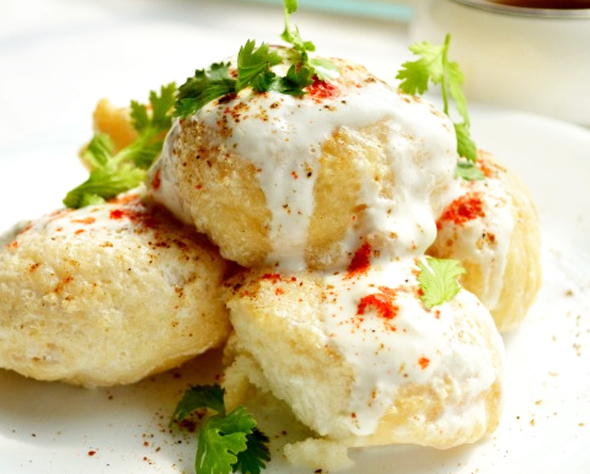Mama’s Punjabi Recipes: Dahi Vadde (Lentil Balls In Yogurt)
Vaddas – which refers to all sorts of edible balls – are popular all across India, where they are cooked in a variety of ways. They can be eaten alone, dipped in a chutney as a snack or cooked in curries for a complete dinner dish. Or they can be soaked in yogurt and eaten as dahin vadde, which is a variation of the popular Punjabi dish known as dahi bhalle. Dahin vadde has become a popular snack in North India, available in many restaurants and especially at roadside stalls where it is eaten drizzled with a tamarind chutney.
The dough for vadde comes from the split and skinless white urad (or mahn in Punjabi) dal which is one of the most prized lentils of India since ancient times. The whole black urad is made into the “dal makhani” which is popular in restaurants the world over. Urad dal is both nutritious and recommended for diabetics. Vaddas are fried pieces of the dough, usually round and hard and can be eaten by themselves with imli (tamarind) or other chutneys or dipped, as in South Indian cuisine, in a sambar.
Dahin has had special significance in India for millennia not only for use in daily life but in many religious and medicinal purposes. Dahin is one of the panchamitras (five nectars), along with honey, sugar, milk and ghee (clarified butter) used in Hindu puja (worship). Dahin has live cultures that can prevent antibiotic-associated diarrhea and is also used in cosmetics, as a hair conditioner and mixed with spices, as a marinade for meats. Full fat dahin has 12% calcium and is high in protein, sugar and carbohydrates.
Ingredients :
250gm urad dal (split and skinless)
1 cup dahi (plain yogurt, preferably 1% fat)
¼ cup doodh (milk, preferably 1% fat)
Tael to fry with (vegetable, sunflower or cannola oil)
Pan of warm pani (water)
Spices to taste: namak (salt), mirch (red pepper), dhania (coriander) powder, garam masala, hing (asafetida), jeera (cumin seed), adrak (ginger) powder
Directions:
1.Soak the urad dal overnight in a pot; it should become swollen by the morning. Drain the water in the morning a few times to get all the dirt out and then pour through a strainer.
2.Place the soaked dal in a blender and grind to a medium thick paste and place in a bowl. Do not use much water while grinding otherwise it will be difficult to fry the vadde.
3.In the ground dal, mix in the namak, mirch, dhania, garam masala and a pinch of hing (to aid in digestion) and set aside. Do not add haldi (turmeric) or lassan (garlic).
4.Pour some oil in a kadai or wok and place over medium high heat.
5.Take a tablespoon of the mixture and gently slide it into the hot oil making a 1 inch ball. Repeat with the rest of the mixture till there are several balls in the oil. This works best with two people: one dropping the balls and the other frying them and taking them out.
6.Turn the balls over till they are slightly brown all over then take them out, then place on a couple of paper towels to soak the excess oil and let them cool down.
7.Place the cooled down vadde in a warm pan of water and let them soak for 5 minutes.
8.Now take each vadda out of the water and squeeze gently between the palms of your hands to remove the water. Be careful not to break them, Return them on the paper towel to cool down some more.
9.In a wide brimmed bowl beat the dahin with a large spoon and then mix in the milk thoroughly to thin it down and add taste. Mix in the spices but do not add salt as yogurt is naturally salty; adding salt will make it shed water and will not keep long.
10.Slide the vadde in, cover and let them soak for an hour in the fridge.
11.When ready to serve, sprinkle with roasted jeera (cumin) and black pepper
MAMA’S TIP OF THE WEEK
FOR ADDED TASTE, MAKE FRESH JEERA (CUMIN) POWDER
The true flavor of Indian food comes not only from using fresh ingredients, but also from using freshly picked herbs and spices that bring out the true aromas and combine with the sauces in the dish to create a wonderful taste. You can tell the difference when you eat the dish!
Jeera (cumin) is an especially potent spice that should be used sparingly and not in every food; though unfortunately many people use it without regard to the dish. To get the full flavor of it but with less after taste, roast the jeera on a hot flat plate or pan, stirring constantly so that it doesn’t burn. Then, place it in a small mortar or mixee and make into a powder. The aroma will explode in the air and you can then sprinkle it, especially on dahin (yogurt).
.
Shakuntla Malhotra is a skilled cook of Punjabi dishes made in the old-fashioned style that she learnt as a young woman in her ancestral home in Lyallpur, India before it became part of Pakistan after the Partition in 1947. People have often admired her cooking for its simplicity and taste that comes with each mouthful. Even in her mid-eighties, she continues to cook daily and agreed to share some of her delectable Punjabi recipes.


